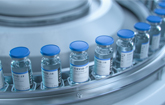
IDEAYA Biosciences Announces Positive Interim Phase 2 Data for Darovasertib in the Neoadjuvant Setting of Primary Uveal Melanoma
- Treatment with darovasertib resulted in robust ocular tumor shrinkage, lower simulated radiation doses to the eye and meaningful visual gains and reduced long-term risk of blindness for patients in the neoadjuvant setting of primary uveal melanoma
- Manageable safety profile with mostly Grade 1 and 2 treatment-related adverse events
- Phase 3 registration-enabling OptimUM-10 trial of darovasertib in neoadjuvant primary UM initiated during the second quarter of 2025
SOUTH SAN FRANCISCO, Calif., Sept. 8, 2025 /PRNewswire/ -- IDEAYA Biosciences, Inc. (Nasdaq: IDYA), a leading precision medicine oncology company, will present positive interim data at their 10-Year Anniversary R&D Day from their ongoing Phase 2 OptimUM-09 trial of darovasertib in the neoadjuvant setting for primary uveal melanoma (UM). The data provide clinical evidence of ocular tumor shrinkage, reduction in radiation doses administered to critical eye structures and, in turn, improved vision with a reduced risk of developing longer-term blindness post-plaque brachytherapy. Today, surgical removal of the eye (enucleation) and invasive radiation treatment applied to the eye (plaque brachytherapy) are the standard(s) of care in the neoadjuvant setting of primary UM and there are no approved systemic therapies. Darovasertib is a potent and selective protein kinase C (PKC) inhibitor being developed to broadly address primary UM and metastatic uveal melanoma (mUM).
"The data presented in this study represents a potential breakthrough advance for subjects with primary uveal melanoma where there currently is no neoadjuvant therapy available that can shrink tumors in this setting," said Dr. Arun D. Singh, Director of the Department of Ophthalmic Oncology at the Cole Eye Institute, Cleveland Clinic. "We are delighted to see the progress we are making with darovasertib as a single agent in subjects with mid-sized tumors requiring plaque brachytherapy," said Dr. Darrin Beaupre, M.D., Ph.D., Chief Medical Officer, IDEAYA Biosciences. "Darovasertib is generally well-tolerated and showing initial evidence of shrinking tumors effectively, and the results imply that the associated radiation reduction observed will likely lead to improvements in vision not only during therapy but post-plaque brachytherapy."
All the data presented are preliminary, and from patients in the plaque brachytherapy cohort of the ongoing Phase 2 OptimUM-09 trial as of a cut-off date of May 23, 2025. A total of 39 patients enrolled were evaluated for safety, including 21 patients who were evaluated for efficacy as of the cut-off date. All efficacy-evaluable patients had received three or more cycles of darovasertib and had baseline and on-treatment tumor assessment, paired dosimetry and visual acuity score (VAS) data available as of the cut-off date.
Key data from the presentation
- 76% (16/21) of patients achieved ≥20% ocular tumor shrinkage by product of diameters, the response definition proposed for the Phase 3 registration-enabling OptimUM-10 trial
- 48% (10/21) of patients achieved ≥20% reduction in simulated radiation dose to at least one key visual structure (optic disc/nerve and/or fovea), with 86% (18/21) achieving any reduction. A 20% reduction in radiation dose has previously been shown to correlate with improved visual outcomes.
- 65% (13/20) of patients observed any visual improvement during neoadjuvant darovasertib treatment, with a median of 6 letters gained, and 40% (8/20) of patients achieving >5 letters gained at two consecutive visits
- A vision prognostication tool used to predict the risk of developing 20/200 vision (defined as legal blindness) at 3 years post-plaque brachytherapy showed 67% (14/21) of patients treated with darovasertib observed "any reduction" in their risk, and 38% (8/21) observed a ≥20% reduction in their risk.
- Darovasertib was generally well-tolerated with a manageable safety profile. The majority of treatment-related adverse events (TRAEs) observed were Grade 1 and 2, with approximately 10% (4/39) Grade 3 or higher. The most common TRAEs included diarrhea, nausea, fatigue, maculo-papular rash, hypotension, and vomiting. Four patients discontinued treatment due to TRAEs, including two with hepatic transaminase increase, one with nausea, vomiting, fatigue, and one with hypotension, bradycardia and decreased level of consciousness.
IDEAYA will review this interim data at their 10-Year Anniversary R&D Day on September 8th in New York. A link to the webcast will be available on the Investor Relations page of the IDEAYA corporate website: https://ir.ideayabio.com/. Additional data from over 90 patients in both the plaque brachytherapy and enucleation cohorts of the OptimUM-09 trial will be presented in a Proffered Paper Oral Presentation at the European Society of Medical Oncology (ESMO) meeting, taking place on October 17-21, 2025 in Berlin, Germany.
About IDEAYA Biosciences
IDEAYA is a precision medicine oncology company committed to the discovery, development, and commercialization of transformative therapies for cancer. Our approach integrates expertise in small-molecule drug discovery, structural biology and bioinformatics with robust internal capabilities in identifying and validating translational biomarkers to develop tailored, potentially first-in-class targeted therapies aligned to the genetic drivers of disease. We have built a deep pipeline of product candidates focused on synthetic lethality and antibody-drug conjugates, or ADCs, for molecularly defined solid tumor indications. Our mission is to bring forth the next wave of precision oncology therapies that are more selective, more effective, and deeply personalized with the goal of altering the course of disease and improving clinical outcomes for patients with cancer.
Forward-Looking Statements
This press release contains forward-looking statements, including, but not limited to, statements related to (i) ) the potential therapeutic benefits of IDEAYA therapeutics, including combination therapies; (ii) the safety profile of darovasertib; (iii) the timing of IDEAYA's 10-Year Anniversary R&D Day; and (iv) the timing of an oral presentation of additional data at ESMO. Such forward-looking statements involve substantial risks and uncertainties that could cause IDEAYA's preclinical and clinical development programs, future results, performance or achievements to differ significantly from those expressed or implied by the forward-looking statements, including those related to success in early clinical trials, especially if based on a small patient sample, does not ensure that later clinical trials will be successful, and early results, including interim results, from a clinical trial do not necessarily predict final results or results of future trials. Such risks and uncertainties include, among others, the uncertainties inherent in the drug development process, including IDEAYA's programs' early stage of development, the process of designing and conducting preclinical and clinical trials, the regulatory approval processes, the timing of regulatory filings, the challenges associated with manufacturing drug products, IDEAYA's ability to successfully establish, protect and defend its intellectual property, and other matters that could affect the sufficiency of existing cash to fund operations. IDEAYA undertakes no obligation to update or revise any forward-looking statements. For a further description of the risks and uncertainties that could cause actual results to differ from those expressed in these forward-looking statements, as well as risks relating to the business of IDEAYA in general, see IDEAYA's Annual Report on Form 10-K dated February 18, 2025 and any current and periodic reports filed with the U.S. Securities and Exchange Commission.
Investor and Media Contact
IDEAYA Biosciences
Joshua Bleharski, Ph.D.
Chief Financial Officer
[email protected]
SOURCE IDEAYA Biosciences, Inc.







Share this article